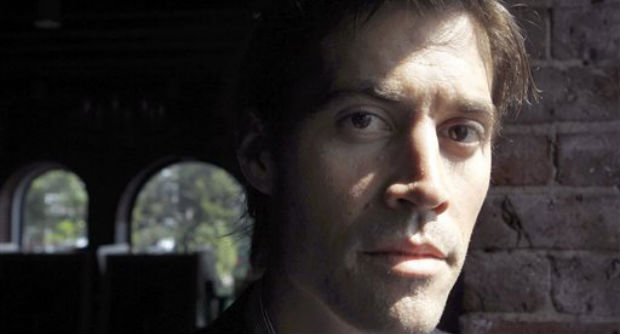
In this Friday, May 27, 2011, file photo, journalist James Foley poses for a photo during an interview with The Associated Press, in Boston. A video by Islamic State militants that purports to show the killing of Foley by the militant group was released Tuesday, Aug. 19, 2014. AP
WASHINGTON — A video by Islamic State militants released Tuesday purported to show the beheading of American journalist James Foley as retribution for U.S. airstrikes in Iraq. The White House, his family and employer said they could not determine the video’s authenticity and were attempting to confirm if he had been killed.
Foley, a 40-year-old freelance journalist from Rochester, New Hampshire, went missing nearly two years ago in northern Syria while on assignment for Agence France-Presse and the Boston-based media company GlobalPost. The car he was riding in was stopped by four militants in a contested battle zone that both Sunni rebel fighters and government forces were trying to control. He had not been heard from since.
White House National Security Council spokeswoman Caitlin Hayden said the administration has seen the video and that the intelligence community is working as quickly as possible to determine if it is authentic.
“If genuine, we are appalled by the brutal murder of an innocent American journalist and we express our deepest condolences to his family and friends,” Hayden said in a statement.
Approached by an Associated Press reporter at her home, Foley’s mother, Diane Foley, was red-eyed and gracious Tuesday afternoon but said the family would not make an immediate statement. A priest arrived at the home several hours later.
Philip Balboni, GlobalPost CEO and co-founder, said the company had been informed that the FBI is in the process of evaluating the video to determine whether it was authentic. “We ask for your prayers for Jim and his family,” he said.
Several senior U.S. officials with direct knowledge of the situation said the Islamic State very recently threatened to kill Foley to avenge the crushing airstrikes over the last two weeks against militants advancing on Mount Sinjar, the Mosul dam and the Kurdish capital of Irbil.
Both areas are in northern Iraq, which has become a key front for the Islamic State as its fighters travel to and from Syria.
The officials spoke on condition of anonymity because they were not authorized to discuss the hostage situation by name.
Since Aug. 8, the U.S. military has struck more than 70 Islamic State targets — including security checkpoints, vehicles and weapons caches. It’s not clear how many militants have been killed in the strikes, although it’s likely that some were.
The Internet video of the apparent beheading appears to show the increasing sophistication of the Islamic State group’s media arm. It begins with scenes of President Barack Obama explaining his decision to order airstrikes in Iraq. Then it switches to a balding man in an orange jumpsuit kneeling in the desert, a black-clad Islamic State fighter by his side. Foley’s name appears in both English and Arabic graphics on screen.
The scene is captured on at least two video cameras, and has been edited in a professional style. The video appears to have been shot in an arid area; there is no vegetation in sight and the horizon is in the distance where the sand meets the gray-blue sky.
The Islamic State militant group is so ruthless in its attacks against all people they consider heretics or infidels that it has been disowned by al-Qaida’s leaders. In seeking to impose its harsh interpretation of Islamic law in the lands it is trying to control, the extremists have slain soldiers and civilians alike in horrifying executions — including mounting the decapitated heads of some of its victims on spikes.
Foley’s purported beheading would mark the first time the Islamic State has killed an American citizen since the Syrian conflict broke out in March 2011, upping the stakes in an increasingly chaotic and multilayered war. If confirmed, the killing is likely to complicate U.S. involvement in Iraq and the Obama administration’s efforts to contain the group as it expands in both Iraq and Syria.
The group is the heir apparent of the militancy known as al-Qaida in Iraq, which beheaded many of its victims, including Americans businessman Nicholas Berg in 2004.
In 2011, Foley was among a small group of journalists held captive for six weeks by the government in Libya and was released after receiving a one-year suspended sentence on charges of illegally entering the country. In a May 2011 interview about his experience, he recounted watching a fellow journalist being killed in a firefight and said he would regret that day for the rest of his life. At the time, Foley said he would “would love to go back” to Libya to report on the conflict and spoke of his enduring commitment to the profession of journalism.
“Journalism is journalism,” Foley said during the AP interview, which was held in GlobalPost’s office in Boston. “If I had a choice to do Nashua (New Hampshire) zoning meetings or give up journalism, I’ll do it. I love writing and reporting.”
The New York-based Committee to Protect Journalists estimated Tuesday that about 20 journalists are missing in Syria, and has not released their nationalities. In its annual report last November, CPJ concluded that the missing journalists are either being held and threatened with death by extremists, or taken captive by gangs seeking ransom. The group’s report described the widespread seizure of journalists as unprecedented and largely unreported by news organizations in the hope that keeping the kidnappings out of public view may help in the captives’ release.
RELATED STORIES